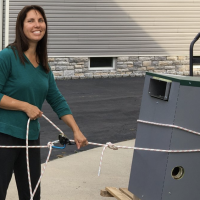Cant get rid of banging, steam pipe from wall.
Hi, I have a single pipe steam system. I can't get rid of banging from this radiator. I've made sure that the valve is fully open and tried adding shims to pitch the radiator towards the pipe. I also hear sloshing sounds when it's heating up.
I think the steam has to go through two turns: vertical pipe behind wall --> elbow to go horizontal thru wall --> elbow --> radiator. Should I check the pitch of the elbows?
Comments
-
-
Try to raise the entire radiator. In the picture, it shows that you have a gap of about an eighth to a quarter inch at the top of the pipe going through the wall trim. If that doesn't work, your thought to check the pitch of the elbow is next followed by what @leaking says above.
1 -
Thanks for your inputs. I shimmed up the radiator but the banging was still there. Checked the basement - there is a pretty long, horizontal supply line right before it goes up to the radiator. I heard the banging noise (though not as loud) while I was in the basement.
my attempt at the schematic is attached. Basically it branches off from the main line, has a short horizontal leg, then makes a turn to the long horizontal run, then turns to go vertical to the radiator.
What's the correct pitch and what's the best way to measure it? I think this horizontal runs about 50-60 ft so I don't think putting a level on one end is going to give me an accurate pitch.
And is increasing the pitch as simple as rasing it up with some pipe hangers? Any concerns with leaking at the joints? If you raise one end, imagine that's going to effect the vertical run?
0 -
too fast a vent on the rad?
known to beat dead horses0 -
-
It's that long horizontal run. They can be a bear… not only must they have the correct overall pitch, end to end, but no sags. And they do sag…
Ideally you would like to have a pitch of 1/2 inch per 10 feet of pipe. You can get away with less under three conditions: one, the pipe size is at least one size bigger than needed for the radiator. Two, you have a slow vent on the radiator. Three, there are — as I said above — no sags. Even so, less than a quarter inch per 10 feet is problematic — but worth an initial try.
Is the pipe insulated? If so, it's a little harder — but doable. If not, it's easy. You will need to have or rent a high-quality builder's laser level. Set it up where it can be used for the full length of the pipe. Then using it measure to the pipe at every hanger and at points half way between each hanger. Then adjust the hangers or add them (they should be not more than 4 feet apart) to get the pipe to the desired pitch.
Br. Jamie, osb
Building superintendent/caretaker, 7200 sq. ft. historic house museum with dependencies in New England1 -
is this a new problem or has it been existing?
0 -
-
-
Okay I finally had a chance this weekend to take some measurements.
The run is 19 ft. (Not 50 ft like I originally guessed 😅). Was able to get a self leveling laser and measured a drop of 2 inches across this 19ft section. So I believe this run should have adequate slope.
In the basement, the piping goes 19 ft --> horizontal 90 deg turn → 6ft -→ 90 deg turn down --> main. I discovered that this 6 ft run is actually pitching up (as condensate is travelling back from radiator to the main) by about 3/4".
So I am thinking I can try to raise the 6ft section by an inch. I think that should give ~0.25" pitch down in the 6ft section but still have 1" drop for the 19' leg still. Attaching a picture of the 6 ft section. You can also see the 19' section to the left.
This is in Portland ME btw and this banging is not new but feels like it's getting worse.
0 -
Sounds like you may have found it — or at least that one! And it probably is getting worse. I'll bet that 19 foot and then 6 foot section have sagged right at that elbow. Hanger gone or loose…
Br. Jamie, osb
Building superintendent/caretaker, 7200 sq. ft. historic house museum with dependencies in New England0 -
Categories
- All Categories
- 87.3K THE MAIN WALL
- 3.2K A-C, Heat Pumps & Refrigeration
- 61 Biomass
- 429 Carbon Monoxide Awareness
- 120 Chimneys & Flues
- 2.1K Domestic Hot Water
- 5.8K Gas Heating
- 115 Geothermal
- 166 Indoor-Air Quality
- 3.7K Oil Heating
- 77 Pipe Deterioration
- 1K Plumbing
- 6.5K Radiant Heating
- 395 Solar
- 15.7K Strictly Steam
- 3.4K Thermostats and Controls
- 56 Water Quality
- 51 Industry Classes
- 50 Job Opportunities
- 18 Recall Announcements








